HISTORICAL BACKGROUND
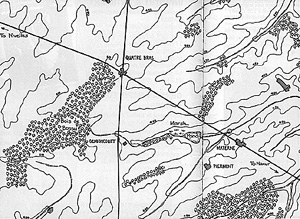 In 1815 Napoleon Bonaparte regained the throne of France and begged the soverign
heads of the major European Powers to allow him to rule his adopted country in
peace. Their reply was to declare war, not on France, but on Napoleon himself. At the
Congress of Vienna the representatives of Austria, Prussia, Russia and Britain each
agreed to place 150,000 men under arms until Napoleon was defeated. As in previous coalitions, Britain was permitted to substitute men for money in the form of a subsidy to the other powers.
In 1815 Napoleon Bonaparte regained the throne of France and begged the soverign
heads of the major European Powers to allow him to rule his adopted country in
peace. Their reply was to declare war, not on France, but on Napoleon himself. At the
Congress of Vienna the representatives of Austria, Prussia, Russia and Britain each
agreed to place 150,000 men under arms until Napoleon was defeated. As in previous coalitions, Britain was permitted to substitute men for money in the form of a subsidy to the other powers.
Larger Map - very slow (107K)
Jumbo Map - very slow (390K)
Napoleon was therefore faced with the choice of waiting for the Allies to gather in overwhelming strength and invade France, or of attacking the individual national armies before they could combine forces. He chose the latter course of action and he selected Wellington's Anglo-Netherlands and Blucher's Prussian armies which were assembling on the Franco-Belgian border as his first targets.
Napoleon's strategy for the campaign in Belgium was based on adopting the central position between Wellington's and Blucher's armies. He intended to thrust his army directly at the point where the two enemy forces met, thus driving them apart. He could then attack each of the opposing armies separately.
Wellington held the firm conviction that Napoleon would attempt to turn the Anglo-Netherlands army's western flank in order to cut the British off from the coast. Even twelve hours after the French army had crossed into Belgium and attacked the Prussians at Charleroi Wellington refused to believe that Napoleon would not threaten his communications with the channel ports.
But with the French little more than a day's march from the Belgian capital he finally realised that he had been "humbugged" and he ordered his troops to move with all speed to the road junction on the Nivelles to Namur highway which linked the British and Prussian armies - the crossroads of Quatre Bras.
THE BATTLEFIELD
Quatre Bras is a little more than twenty miles south of Brussels. The four arms from which this crossroads takes its name are formed by the junction of the Nivelles-Namur highway with the main road from Charleroi to Brussels. Quatre Bras itself consisted of just a few buildings situated on three of the four corners of the junction, the largest construction being a farm building. Immediately to the west of the crossroads was the Bois be Bossu. This wood, which to 750 yards wide and ran northwestwards from Quatre Bras for approximately 3,000 yards. It effectively marked the western edge of the battlefield.
Today virtually nothing remains of the wood. Just over a mile southeastwards from Quatre Bras and 200 yards south of the Namur road is the Marene pond and marshes, and a further 500 yards in the same direction is the tiny hamlet of Piermont which formed the battlefield's eastern limit.
The Nivelles-Namur highway constituted the northern perimeter of the battlefield and the fighting for Quatre Bras proper began around the farm of Gemioncourt 1,300 yards south of the crossroads. From the Materne pond runs a line of trees which reach almost as far as Gemioncourt, and opposite the pond on the northern side of the Namur road is a small wood. The ground around Quatre Bras undulates gently between 400 and 500 feet above sea level, and the fields to the south of the crossroads were covered with high-standing
THE ANGLO-NETHERLANDS ARMY
A contingent of Wellington's army under the command of the Prince of Orange was in possession of the ground in front of Quatre Bras:
PRINCE OF ORANGE'S FORCES
2nd Netherlands Dickson
| 1st Brigade (Bijlandt) Men | Men |
| 27th (Dutch) Chasseurs | 809 |
| 5th, 7th and Pith Militia Battalions | 1723 |
| . | |
| 2nd Brigade (Saxe-Weimar) | Men |
| 2nd Regiment of Nassau (3 Btns) | 2709 |
| Regiment of Orange Nassau (2 Btns) | 1591 |
| . | |
| TOTAL | 6832 |
| Artillery | 16 Guns |
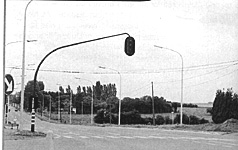 The first line taken up by Perponcher's division in front of Quatre Bras was approximately two miles south of the crossroads around the village of Frasnes. As the French advanced upon Frasnes the Netherlanders withdrew towards Quatre Bras, making a stand at Gemioncourt. The Prince of Orange placed one battalion in the farm and the rest of his force formed a line from Piermont on the left to the Bossu wood which the Netherlanders occupied as far as its western edge.
The first line taken up by Perponcher's division in front of Quatre Bras was approximately two miles south of the crossroads around the village of Frasnes. As the French advanced upon Frasnes the Netherlanders withdrew towards Quatre Bras, making a stand at Gemioncourt. The Prince of Orange placed one battalion in the farm and the rest of his force formed a line from Piermont on the left to the Bossu wood which the Netherlanders occupied as far as its western edge.
At right, the crossroads of Quatre Bras today.
Wellington rode up to Quatre Bras at this time and he approved of these dispositions. The Prince had taken advantage of the principle natural and man-made features of the ground. He had secured both flanks as much as was possible and the centre of his position was strengthened by the strongpoint of Gemioncourt.
THE FRENCH ARMY
Napoleon divided his army into two wings. The smaller of which was entrusted to Marshal Ney, its objective being to sieze Quatre Bras and prevent the Anglo-Netherlands army from being able to march to the assistance of the Prussians whom Napoleon intended to attack with the other, larger, wing.
Ney approached Gemioncourt with the following troops of Count Reille's First Corps:
Ney's Forces
| 5th Infantry Division (Baehelu) | |
| 1st Brigade | |
| 2eme Leger, 61eme de Ligne | |
| 2nd Brigade | |
| 72eme, 108eme de Ligne | 5003 men |
| . | |
| 6th Infantry Division (Jerome Bonaparte) | |
| 1st Brigade | |
| 1er, 3eme Leger | |
| 2nd Brigade | |
| 1er, 2eme de Ligne | 6591 men |
| . | |
| 9th Infantry Division (Foy) | |
| 1st Brigade | |
| 4eme Leger, 92eme | |
| 2nd Brigade | |
| 93eme, 100eme de Ligne | 4595 men |
| . | |
| 2nd Cavalry Division (Pire) | |
| 1st Brigade | |
| 1er 6eme Chasseurs a cheval | |
| 2nd Brigade | |
| 5eme, 6eme Chevau-leger lanciers | 1729 men |
| . | |
| TOTAL | 17918 men |
| Artillery | 38 Guns |
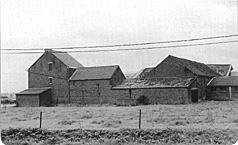 Ney made repeated assaults upon Gemioncourt, and part of Bachelu's division moved against
Piermont. The weight of the French attack caused Orange to contract his front and he abandoned
Piermont and withdrew the bulk of his forces into the protection of the wood whilst still trying to hold Gemioncourt.
Ney made repeated assaults upon Gemioncourt, and part of Bachelu's division moved against
Piermont. The weight of the French attack caused Orange to contract his front and he abandoned
Piermont and withdrew the bulk of his forces into the protection of the wood whilst still trying to hold Gemioncourt.
Eventually the farm also had to be evacuated and the Dutch-Belgian troops withdrew through the wood towards Quatre Bras.
At this stage of the battle Wellington's reinforcements began to arrive on the field. The Duke now assumed command of the allied force which was as follows:
ALLIED FORCES
| 2nd Netherlands Division | Men |
| (Perponcher) | 6832 |
| . | |
| 3rd Netherland cavalry Brigade (Merlen) | |
| 5th (Belgian) Light Dragoons | 441 |
| 6th (Dutch) Hussars | 641 |
| . | |
| 5th (Anglo-Hanoverian) Division (Picton) | |
| 8th British Brigade (Kempt) | |
| 28th, 32nd, 79th & 95th Regiments | 2471 |
| 9th British Brigade (Pack) | |
| 1st, 42nd, 44th & 92nd Regiments | 2173 |
| 4th Hanoverian Brigade | |
| Landwehr Btns, Verden, Luneburg, Osterode & Minden | 2582 |
| . | |
| Brunswick Corps (Duke of Brunswick) | |
| Avantgarde | 672 |
| Leib-Batallion, 2nd Leicht-Batallion | 1344 |
| 1st, 2nd, & 3rd Linien-Batallion | 2016 |
| Husaren-Regiment | 690 |
| Uhlan | 232 |
| . | |
| TOTAL | 20294 |
| Artillery | 38 Guns |
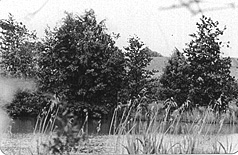 At right, the Materne pond viewed from the north. The ground is still marshly and the surrounding wood quite dense.
At right, the Materne pond viewed from the north. The ground is still marshly and the surrounding wood quite dense.
With this increase in force Wellington attempted to re-take the key features of the battlefield. He sent two battalions down the Namur road to occupy Piermont but Bachelu's men had already siezed the hamlet. So the 1st Btn. 95th Rifles and the 2nd Brunswick Leithte-Btn. took up a line from behind the Materne pond to, and including, the small wood north of the Namur road. These two battalions held this position throughout the remainder of the battle and prevented Ney from turning the Allied left flank The Brunswick Avantgarde were sent into the Bossu wood to support the Netherlanders who still held the northern end of the wood, and with Picton's two British divsions and with part of the Brunswick corps Wellington tried to recapture Gemionmcourt. The rest of the Brunswickers and the Havoverian brigade of the 5th Division took up defensive positions amongst the buildings of Quatre Bras and along the section of the Namur road adjacent to the crossroads.
The French had now taken up the line previously held by the Netherlanders, streching from Bossu wood to Piermont with Gemioncourt in the centre. Ney had placed the bulk of his artillery in battery on the slight rise to the east of the farm from which elevation the guns were able to sweep the whole ground from the Materne pond to the Bossu wood as far as the Namur road.
Wellington's advance towards Gemioncourt was repulsed and his troops retired to take up positions along the Namur road. Ney followed up the allied withdrawal by driving the Netherlanders back to the northern edge of the wood and by delivering a series of cavalry attacks against Picton's division and the Brunswickers.
After the first of these attacks Ney's force was augmented by a brigade of Kellermann's 11th cavalry Division. The currasiers immediately joined in the cavalry attacks upon the allied squares. Because of the height if the rye in the fields a number of British regiments were caught unprepared by the French cavalry and they sustained heavy casualties.
Hanging in the Balance
The outcome of the battle hung in the balance. The Netherlanders had been driven out of the wood and Wellington's right flank was in jeopardy when more allied reinforcements arrived on the field and saved Wellington from disaster. As his numbers increased Wellington was able to stabilize his position at Quatre Bras and eventually to return to the offensive. Wellington continued to advance until he had recaptured Piermont, Gemioncourt and the whole of the Bossu wood and he had, once again, established the secure position adopted by the Prince of Orange at the start of the battle.
CONCLUSIONS
The visitor to Quatre Bras today sees a very ordinary rural landscape. Rolling fields, a few houses, some trees, a pond, a farm. None of the steep hills and craggy slopes that formed the obvious defensive positions of Busacohere. Yet the entire battle was a struggle for possession of the prominent features of the ground.
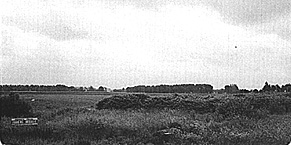 At left, a view from the Namur road looking towards Gemioncourt. This shows
the whole of centre of the battlefield where most of the French
cavalry charges were delivered and recieved. The line of trees
in the distance runs away to the left towards the Materne pond.
At left, a view from the Namur road looking towards Gemioncourt. This shows
the whole of centre of the battlefield where most of the French
cavalry charges were delivered and recieved. The line of trees
in the distance runs away to the left towards the Materne pond.
The commanders on both sides wanted to rest their flanks on the security of man-made defences and they found a tiny hamlet, or the solid structures of nature and they found a simple wood. They wanted impassable terrain in their front and they saw a rustic pond, and they sought a bastion in the centre of their line and it was nought but a country farm. Even the crops that history of the Waterloo campaign grew in the fields were important and factors in the battle of Quatre Bras - the battle for a road junction.
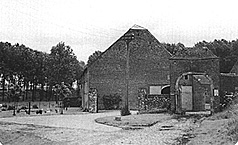 The farm of Gemioncourt seen from the west or Charleroi road side.
The farm of Gemioncourt seen from the west or Charleroi road side.
BIBLIOGRAPHY
Fortescue, J. A History of the British Army, vol. x 1920
Pericoili, U. 1815: The Armies at Waterloo 1973
Schon, A. One Hundred Days 1993
Siborne, H. Waterloo Letters 1993 reprint
Siborne, W. History of the Waterloo Campaign 1995, reprint
Back to Battlefields Vol. 1 Issue 6 Table of Contents
Back to Battlefields List of Issues
Back to Master Magazine List
© Copyright 1997 by Partizan Press.
This article appears in MagWeb (Magazine Web) on the Internet World Wide Web.
Other military history articles and gaming articles are available at http://www.magweb.com